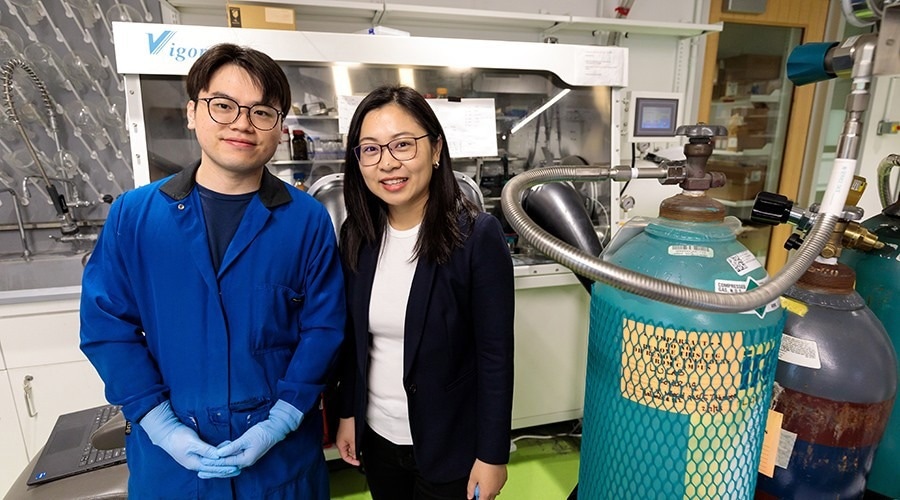Reviewed by Lexie CornerJun 10 2024
In a recent study published in Nature Communications, scientists at the University of Chicago's Pritzker School of Molecular Engineering (PME) have refined a novel technique for removing lithium from more diluted and abundant sources of the mineral, such as groundwater, seawater, and “flow back water” from offshore oil drilling and hydraulic fracturing.
 In a new study, UChicago Pritzker Molecular Engineering Assistant Professor Chong Liu (right), Ph.D. student and First Author Gangbin Yan (left), and Co-authors optimized a new method for extracting lithium from more dilute and widespread sources. Image Credit: John Zich.
In a new study, UChicago Pritzker Molecular Engineering Assistant Professor Chong Liu (right), Ph.D. student and First Author Gangbin Yan (left), and Co-authors optimized a new method for extracting lithium from more dilute and widespread sources. Image Credit: John Zich.
The market for electric vehicles is expanding, and with it, so is the need for lithium (the mineral needed to make lithium-ion batteries). Over the past ten years, lithium production has more than tripled worldwide.
However, the techniques used to extract lithium from rock ores or brines are labor-intensive, expensive, and energy-intensive. They also need lithium reserves, which are first extremely concentrated and limited to a few countries.
Right now, there is a gap between the demand for lithium and the production. Our method allows the efficient extraction of the mineral from very dilute liquids, which can greatly broaden the potential sources of lithium.
Chong Liu, Neubauer Family Assistant Professor and Study Senior Author, Department of Molecular Engineering, University of Chicago
In their recent research, Liu and her colleagues demonstrated how specific iron phosphate particles can most efficiently extract lithium from dilute solutions. Their latest research may usher in a speedier, more environmentally friendly era of lithium extraction.
Lithium at a Cost
Two primary extraction methods provide most of the lithium needed in lithium batteries. Large machinery can mine the ore, smash it up, and then treat it with acid to extract lithium from lithium rock ores. On the other hand, lithium brine pools use large volumes of water pumped to the earth's surface, which is then evaporated for more than a year to produce dried lithium.
These methods are not particularly environmentally friendly, to begin with, and if you start trying to work with less concentrated sources of lithium, they are going to become even less efficient. If you have a brine that is ten times more dilute, you need ten times more briny water to get the same amount of lithium.
Chong Liu, Neubauer Family Assistant Professor and Study Senior Author, Department of Molecular Engineering, University of Chicago
Liu's group has developed a new technique for extracting lithium from diluted liquids. They isolate lithium based on its electrochemical properties using olivine iron phosphate crystal lattices.
Lithium is attracted into the olivine iron phosphate columns' spaces due to its size, charge, and reactivity—as if water is being soaked into a sponge's holes. However, if the column is designed correctly, sodium ions present in briny liquids are either excluded or enter the iron phosphate at significantly lower levels.
In the recent study, Liu and her colleagues, including Gangbin Yan (a PMA graduate student and the paper's first author), investigated how variations in olivine iron phosphate particles influenced their capacity to selectively separate lithium from sodium.
When you produce iron phosphate, you can get particles that are drastically different sizes and shapes...To figure out the best synthesis method, we need to know which of those particles are most efficient at selecting lithium over sodium.
Gangbin Yan, Graduate Student, University of Chicago
Not Too Big, Not Too Small
The research team used techniques to synthesize olivine iron phosphate particles, producing multiple particle sizes from 20 to 6,000 nm. They then sorted those particles into groups according to size to construct electrodes capable of drawing lithium out of a weak solution.
They found that iron phosphate particles allowed more sodium into their structures when they were too big or small, resulting in fewer pure lithium extractions.
Liu said, “It turned out that there was this sweet spot in the middle where both the kinetics and the thermodynamics favor lithium over sodium.”
The results are essential to advancing electrochemical lithium extraction into a marketable product. They recommend that, instead of concentrating only on generating olivine iron phosphate, researchers should focus on manufacturing it at the optimal particle size.
Liu said, “We have to keep this desired particle size in mind as we pick synthesis methods to scale up, but if we can do this, we think we can develop a method that reduces the environmental impact of lithium production and secures the lithium supply in this country.”
Co-authors include Emory Apodaca, Suin Choi, Peter J. Eng, Joanne E. Stubbs, Yu Han, Siqi Zou, Mrinal K. Bera, and Ronghui Wu of the University of Chicago; Jialiang Wei and Wei Chen of Illinois Institute of Technology; and Evguenia Karapetrova and Hua Zhou of Argonne National Laboratory.
The National Science Foundation and the Department of Energy Office of Science supported this research.
Journal Reference:
Yan, G., et al. (2024) Identifying critical features of iron phosphate particle for lithium preference. Nature Communications. doi.org/10.1038/s41467-024-49191-3